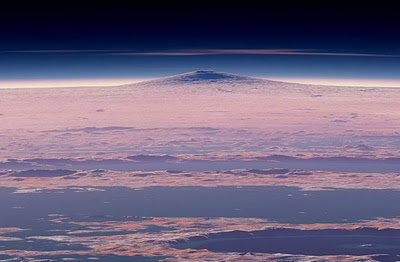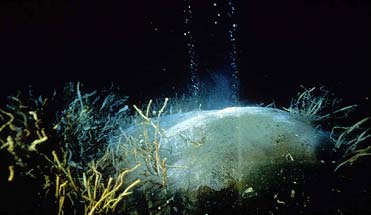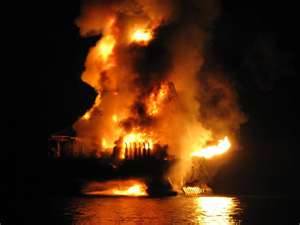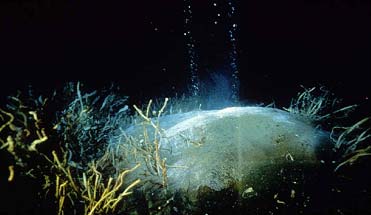Three stories about methane have caught my eye this week. The first is an off the planet story about the mystery of methane on Mars. The other two are about methane right here on Earth. Well not exactly on the Earth, but on the seafloor. I hope you find all to be of interest.
Curiosity Out to Discover Why There is Methane on Mars
We have known from the Mars Express, an orbiter circling Mars, that the planet cyclically exhales methane gas but what has not been ascertained is whether this is chemically or biologically induced. Well it seems that Curiosity with its Sample Analysis at Mars instrument, called SAM for short, is sniffing the Martian atmosphere at Gale Crater and may soon have an answer to this mystery.
Why is methane on Mars considered odd? Because methane has a chemical lifetime of between 300 and 600 years and if it was produced some time from a past geological event it would have long since oxidized to become CO2. But Mars Express has measured the rise and fall of methane in the Northern Hemisphere of the planet and these rise and falls correlate with the change of seasons.
There are two explanations. The first is biological. The second is chemical.
If biological the methane could be coming from living microorganisms or from microbes long dead whose exhalations froze in the Martian subsurface and periodically release when the temperatures at the surface rise during the Martian summer. In 2003 and 2006 Mars Express observed methane concentration in three areas of the planet. All areas appeared to have once had flowing water. If that water froze and formed a subsurface ice layer, there could be microorganisms living below the ice layer.
If chemical the methane could come from a Martian subsurface spring, or from vulcanism, or from trapped methane preserved in geological structures that when exposed to liquid water releases the gas. We have considerable visual evidence that salt-laden water briefly shows up on Mars causing flow patterns on valley walls. So if methane is trapped in sedimentary formations these flows could be the trigger.
As Curiosity wanders across the Gale Crater floor and samples the soil and drills in rocks, SAM will be smelling the air. As it gathers data we may finally have an answer to support the original findings of the Viking landers which were first discounted. We may be witnessing evidence of Martian life.

Variations in the Flow of the Gulf Stream May Release Trapped Methane from the Ocean Floor
If you watched the revival of Dallas on television this year then you know that Christopher, Bobby Ewing’s adopted son, was working to unlock the energy stored in methane hydrate. I have written about hydrates before. These are frozen deposits that can be found on the sea floor or just below it in sedimentary formations. Hydrates form at low temperatures under high pressure as methane gas leaks from under the sea floor into the cold water above. Hydrates represent a potential rich source of energy if we can discover a way to harvest them without them blowing up.
But one of this week’s stories is about changes in the temperature of the Gulf Stream as it carries water from the Gulf of Mexico into the North Atlantic. What scientists recently observed is the heating of sediments by the Stream along a strip of seafloor that contains an estimated 2.5 billion metric tons of methane hydrate. The study, which was reported in this month’s Nature, indirectly measured the seafloor temperature and concluded that the hydrates may be disintegrating.
In the past it has been proposed that sudden releases of methane from hydrates caused a global warming event 55 million years ago. If the present hydrates are melting, the methane released will have about a ten year life in the atmosphere before oxidizing. But hydrate releases don’t just affect the atmosphere. They can cause subsurface slides along the edge of the continental shelf. And slides could accelerate the release of the frozen gas.

Was the BP Deepwater Horizon Disaster Caused by Methane Ice and Human Error?
When survivors of the BP drilling rig explosion described what happened on April 20, 2010 they talked about the process they engaged in prior to the explosion. This involved decreasing the pressure in the drill column and applying heat to the concrete cap to set it at the wellhead. What followed was an explosion on the rig platform caused by a sudden release of methane. It packed enough of a wallop to blow away much of the rig’s superstructure and resulted in the subsequent fire and crippling damage at the base of the drill column.
The Deepwater Horizon was parked over the Mississippi Canyon in the Gulf of Mexico. This geological formation had suspected hydrate-bearing sediments. And even if there were no hydrates present, the intense cold and pressure experienced at the drill base could produce methane hydrate crystallization that would rapidly clog the drilling column. This should have been known to the drilling crew because methane hydrates are a recognized industry hazard in deepwater drilling. The American Association of Drilling Engineers has published information about cementing processes in the presence of hydrates cautioning operators to allow extra time for cementing the wellhead to prevent hydrate destabilization. But apparently the cementing operation was carried out as if no methane hydrate hazard existed. And because the blowout preventer on the ocean floor had previously been damaged weeks before and not been repaired, when the methane expanded all hell broke loose and millions of barrels of oil spilled into the Gulf.


















Len, I know this is off-topic for this blog. but I would like to comment on the issues of AI/human combinations and the ideas of tech driven immortality sometime. Particularly the social disruption this will cause.
Hi Ricky, I think technology and immortality are very much on topic for this blog site. Last night I woke up suddenly with the thought about writing about religion and the belief in super beings. What does this have to do with technology and immortality? Think of a technical society with a million year head start on us. A million years is nothing in the scale of the cosmos but in terms of technological progress it is beyond our imagination. A million years ago we were on the Serengeti plains of Africa mastering fire, flint and stone tools. Now imagine us a million years in the future. Will we be human or a synthesis of technology and intelligence? Will we be immortal? Will we be able to project ourselves through technology to almost anywhere in the galaxy? Will intelligent creatures a million years behind us see us as gods?
So Ricky, what do you have in mind that you want to say?